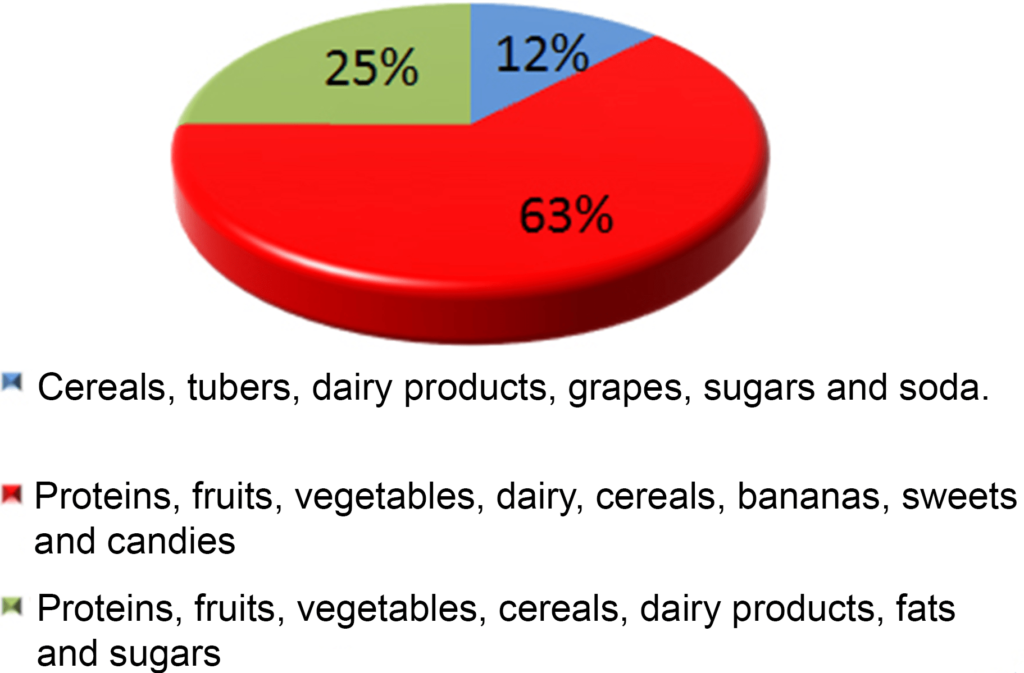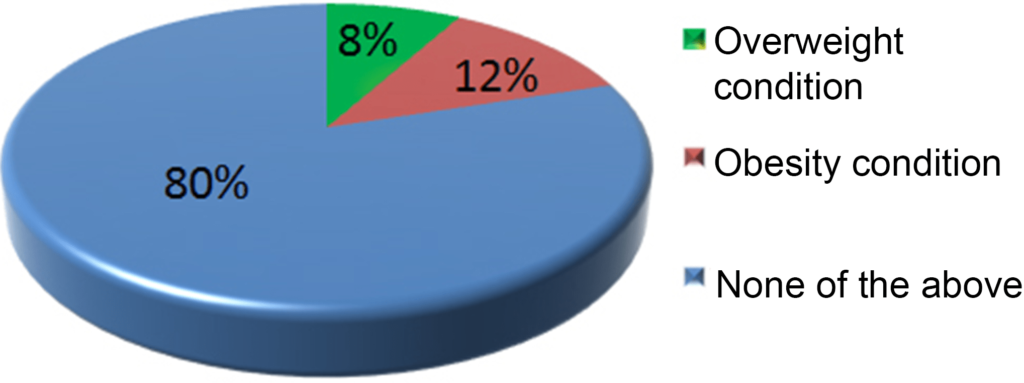1. De la Fuente A. Human Capital and growth in the knowledge economy. 2003.
2. De Maio FG. Understanding chronic non-communicable diseases in Latin America: Towards an equity-based research agenda. Global Health. 2011; 7(1): 36. doi: 10.1186/1744-8603-7-36
3. World Health Organization (WHO). Global health statistics. A mine of information on global public health (2014). Web site. http://apps.who.int/iris/bitstream/10665/112739/1/WHO_HIS_HSI_14.1_eng.pdf. Accessed January 30, 2016.
4. Executive summary, National Survey of Nutrition Status in Colombia. 2010. Colombian Family Welfare Institute.
5. Harnack L, Lytle L, Himes Story M, Taylor G, Bishop D. Low awareness of overweight status among parents of preschool-aged children, Minnesota, 2004-2005. Prev Chronic Dis. 2009; 6(2): A47. Web site. https://www.cdc.gov/pcd/issues/2009/Apr/08_0043.htm. Accessed January 30, 2016.
6. Del Campo ML, Vara Messler M, Navarro A. Food-nutritional education (EAN) in primary education municipality of Cordoba: An experience in participatory action research. Cordoba, Spain: Municipality of Cordoba; 2008.
7. Herrero R, Fillat JC. Influence of a nutritional education program on the modification of breakfast in a group of adolescents. Instituto Miguel Catalán. Department of Health. Saragossa. Statistics and Operational Research Area. University of La Rioja Nutr Clin Diet Hosp. 2010; 30(2): 26-32.
8. Jaimovich S, Campos C, Campos S, More J, Pawloski L, Gaffney K. Nutritional status and behaviors associated with nutrition in schoolchildren. Rev Chil Pediatric. 2010;
9. Decree 1860 of 1994: Partial regulation of the law 115 of 1994- National Level. Web site. http://www.alcaldiabogota.gov.co/sisjur/normas/Norma1.jsp?i=1289. Accessed January 30, 2016.
10. Jansen W, Borsboom G, Meima A, et al. Effectiveness of a primary school-based intervention to reduce overweight. Int J Pediatr Obes. 2011; 6(2-2): e70-e77. doi: 10.3109/17477166.2011.575151
11. Leatherdale ST, Wong S. Modifiable factors associated with sedentary behaviours among youth. Int J Pediatr Obes. 2008; 3: 93. doi: 10.1080/17477160701830879
12. National Guidelines for the Application and Development of Strategies for Healthy Environments. Healthy School and Healthy Housing. Ministry of Social Protection. 2006.
13. Alcaldía Mayor de Bogotá. Continuación de la resolución por la cual se estableceada y saludable, y la regulación del consumo de alimentos y bebidas en centros educativos. Secretaria de educación. Resolución 234. Tiendas escolares. 2010.
14. Menéndez García RA, Franco Díez FJ. Advertising and food: Influence of graphic advertisements on the dietary patterns of childhood and adolescence. Nutr Hosp. 2009; 24: 318-325.
15. de Santiago Restoy L. Cambios en el consumo de fruta y verdura en estudiantes de 2.° de ESO después de seguir un programa de educación nutricional [In Spanish]. Journal of Clinical Nutrition and Hospital Dietetics. 2012; 26. Web site. http://www.sedca.es/publicaciones/revista_2012_01/CAMBIOS.pdf. Accessed January 30, 2016.
16. Merino B, González E, Aznar S, Webster T. Physical Activity and Health in Childhood and Adolescence, Guide for all people involved in their education. Ministry of Health and Consumer Affairs, Ministry of Education and Science. 2010.
17. Corbin CB, Lindsey R. Fitness for Life-Updated. 5th ed. USA; Human Kinetics; 2007: 64.
18. Blair, SN, Davey Smith G, Lee IM, et al. A tribute to Professor Jeremiah Morris: The man who invented the field of physical activity epidemiology. Ann Epidemiol. 2011; 20(9): 651-660. doi: 10.1016/j.annepidem.2010.06.001
19. Aranceta Bartrina J, Serra Majem L, Ribas Barba L, Pérez Rodrigo C. Determinants of obesity in the Spanish infant and juvenile population. In: Serra Majem L, Aranceta Bartrina J, eds. Childhood and Juvenile Obesity. Studio in Kid. Barcelona, Spain: Editorial Masson; 2001; 109-128.
20. Lee IM, Shiroma EJ, Lobelo F. Lancet Physical Activity Series Working Group. Effect of physical inactivity on major non-communicable diseases worldwide: An analysis of burden of disease and life expectancy. Lancet. 2012; 380(9838): 219-229. doi: 10.1016/S0140-6736(12)61031-9
ANNEXES
ANNEXES 1: Questionnaire for the Assessment of Knowledge on Food And Practice of Physical Activity as Protective Factors of Overweight and Obesity in Students of Cycle IV in Official Schools of Sopó Municipality.
Below you will find a series of questions that aim to evaluate your knowledge regarding overweight, obesity, practice of physical activity and adequate food according to the curricula of the areas of Natural Sciences and Physical Education Recreation and Sports. The questionnaire consists of 20 questions, with a single correct answer alternative. Please fill in the oval in the answer sheet, with the option that you consider correct.
BASIC DATA
Educational institution: ___________________________________________________________
Grade: ___________________
Age: ______________________________
Gender: Female: ___Masculine: ___
From what grade are you in the institution: _______________
Currently lives in the area: Rural___________ Urban _________
1. Which of the following activities are basic forms of movement?
a. The force
b. The resistance
c. Walking and running
2. During the last 7 days, on how many days did you walk for at least 10 minutes in a row?
a. Two days
b. Three or more days
c. not on the way
3. Do you mean the care and grooming of the body?
a. Body hygiene
b. Mental hygiene
c. Environmental higiene
4. Are they part of healthy lifestyles?
a. Eating and practicing physical activity
b. Positive thinking
c. Watch television and surf the internet
5. Is the body mainly hydrated?
a. Maintenance of healthy bones
b. Recover or supplement lost fluids
c. Reduce hunger and quench thirst
6. Overweight and obesity refer to?
a. An illness
b. A lifestyle
c. A habit
7. One of the ways to identify a healthy food is through?
a. Its taste and texture
b. The label
c. Its price
8. Physical condition refers to?
a. A set of capacities or motor qualities that can be improved through the practice of physical activity and that serve to carry out daily activities.
b. A set of exercises to improve muscular endurance and breathing.
c. A set of skills and abilities to communicate in society.
9. Identify a healthy eating habit through the following actions?
a. Consume several servings of vegetables and fruits per day
b. Drinking soft drinks several times a day
c. Consume products based on flour and sugars several times a day
10. Does food play an essential role in obtaining energy from humans, which of the following statements do you consider corresponds to the characteristics of healthy eating?
a. Must be varied and balanced
b. Must be rich in carbohydrates and proteins
c. Must be based on dried fruits and vegetables
11. Are the main components of physical activity?
a. Frequency, intensity and time
b. Stretching, exhaustion, and fatigue
c. Strength and endurance and speed
12. To prevents diseases such as being overweight and obese, is it recommended?
a. Prepare food without excess salt, fats and sauces.
b. Play and engage in physical activity occasionally
c. Consume foods outweigh the number of calories we can spend on a daily basis.
13. Is the main objective of warm-up and stretching?
a. Prepare the muscles and joints for different physical demands.
b. Improve physical abilities for two hours.
c. Improve the technical fundamentals of a given sport.
14. Are you currently in overweight or obese condition?
a. Overweight
b. Obese
c. None of the above
15. Overweight and obesity are defined as?
a. A disease of the central nervous system
b. A health problem affecting children and adolescents who eat fruits and vegetables
c. An abnormal or excessive accumulation of fat that can be harmful to health.
16. One of the functions of food sources of protein is reflected?
a. In the formation of muscular tissue
b. In decreasing body weight
c. In increasing percentage of fat in the body
17. Does the “healthy dish” strategy contain the following foods?
a. Cereals, tubers, dairy products, fats and sugars.
b. Proteins, fruits vegetables and dairy.
c. proteins, fruits vegetables, cereals, tubers, dairy products, fats and sugars
18. Which of the following foods do you consider to be a source of protein?
a. Grains such as beans, lentils and chickpeas
b. Fruits and vegetables apple and orange
c. Soft drinks
19. Is vigorous and moderate are one of the most important characteristics of?
a. The types of bones that run through our body
b. The membranes of the digestive system
c. Physical activity
20. Is the Body Mass Index (BMI) important for health because it allows?
a. Identify sexually transmitted diseases that can impair health
b. Identify the type of exercises a person should do to improve health.
c. Identifying chronic noncommunicable diseases such as overweight and obesity







